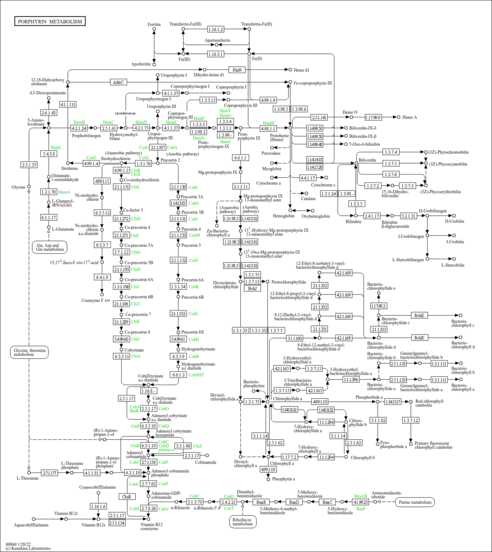| Identification |
|---|
| YMDB ID | YMDB00882 |
|---|
| Name | Heme A |
|---|
| Species | Saccharomyces cerevisiae |
|---|
| Strain | Baker's yeast |
|---|
| Description | Heme a is a derivative of protoheme IX (heme b or heme). Heme a differs from heme b in that a methyl side chain at ring position 8 is oxidized into a formyl group, and one of the vinyl side chains, at ring position 2, has been replaced by an isoprenoid chain. In the heme biosynthesis from uroporphyrinogen-III pathway, different derivatives of protoheme can actually be formed that differ in modifications to the porphyrin ring, including how it is bound to the protein (e.g. heme o, heme a, heme c, and heme d). [Biocyc PWY-5189] |
|---|
| Structure | |
|---|
| Synonyms | - (SP-4-2)[7-ethenyl-17-formyl-12-[(4E,8E)-1-hydroxy-5,9,13-trimethyl-4,8,12-tetradecatrienyl]-3,8,13-trimethyl-21H,23H-porphine-2,18-dipropanoato(4-)-kappaN21,kappaN22,kappaN23,kappaN24]-Ferrate(2-)
- [SP-4-2-(E,E)]-[7-ethenyl-17-formyl-12-(1-hydroxy-5,9,13-trimethyl-4,8,12-tetradecatrienyl)-3,8,13-trimethyl-21H,23H-porphine-2,18-dipropanoato(4-)-N21,N22,N23,N24]-Ferrate(2-)
- Heme a
|
|---|
| CAS number | 57560-10-8 |
|---|
| Weight | Average: 852.837
Monoisotopic: 852.354927677 |
|---|
| InChI Key | KZGQHTJCCRPHLY-AXLBWSHISA-N |
|---|
| InChI | InChI=1S/C49H56N4O6.Fe/c1-9-34-31(6)39-25-45-49(46(55)18-12-17-30(5)16-11-15-29(4)14-10-13-28(2)3)33(8)40(52-45)24-44-37(27-54)36(20-22-48(58)59)43(53-44)26-42-35(19-21-47(56)57)32(7)38(51-42)23-41(34)50-39;/h9,13,15,17,23-27,46,55H,1,10-12,14,16,18-22H2,2-8H3,(H,56,57)(H,58,59);/q-2;+4/b29-15+,30-17+,38-23-,40-24-,42-26-,45-25-; |
|---|
| IUPAC Name | 4,20-bis(2-carboxyethyl)-15-ethenyl-5-formyl-10-[(4E,8E)-1-hydroxy-5,9,13-trimethyltetradeca-4,8,12-trien-1-yl]-9,14,19-trimethyl-2lambda5,22,23lambda5,25-tetraaza-1-ferraoctacyclo[11.9.1.1^{1,8}.1^{3,21}.0^{2,6}.0^{16,23}.0^{18,22}.0^{11,25}]pentacosa-2,4,6,8,10,12,14,16(23),17,19,21(24)-undecaene-2,23-bis(ylium) |
|---|
| Traditional IUPAC Name | 4,20-bis(2-carboxyethyl)-15-ethenyl-5-formyl-10-[(4E,8E)-1-hydroxy-5,9,13-trimethyltetradeca-4,8,12-trien-1-yl]-9,14,19-trimethyl-2lambda5,22,23lambda5,25-tetraaza-1-ferraoctacyclo[11.9.1.1^{1,8}.1^{3,21}.0^{2,6}.0^{16,23}.0^{18,22}.0^{11,25}]pentacosa-2,4,6,8,10,12,14,16(23),17,19,21(24)-undecaene-2,23-bis(ylium) |
|---|
| Chemical Formula | C49H56FeN4O6 |
|---|
| SMILES | [H]OC(=O)C([H])([H])C([H])([H])C1=C(C2=C([H])C3=[N]4C(=C([H])C5=C(C(=C6C([H])=C7C(C([H])=O)=C(C8=[N]7[Fe++]4(N2C1=C8[H])N56)C([H])([H])C([H])([H])C(=O)O[H])C([H])([H])[H])C([H])(O[H])C([H])([H])C([H])([H])C([H])=C(C([H])([H])[H])C([H])([H])C([H])([H])C([H])=C(C([H])([H])[H])C([H])([H])C([H])([H])C([H])=C(C([H])([H])[H])C([H])([H])[H])C(=C3C([H])=C([H])[H])C([H])([H])[H])C([H])([H])[H] |
|---|
| Chemical Taxonomy |
|---|
| Description | belongs to the class of organic compounds known as metallotetrapyrroles. These are polycyclic compounds containing a tetrapyrrole skeleton combined with a metal atom. |
|---|
| Kingdom | Organic compounds |
|---|
| Super Class | Organoheterocyclic compounds |
|---|
| Class | Tetrapyrroles and derivatives |
|---|
| Sub Class | Metallotetrapyrroles |
|---|
| Direct Parent | Metallotetrapyrroles |
|---|
| Alternative Parents | Not Available |
|---|
| Substituents | Not Available |
|---|
| Molecular Framework | Not Available |
|---|
| External Descriptors | Not Available |
|---|
| Physical Properties |
|---|
| State | Solid |
|---|
| Charge | 2 |
|---|
| Melting point | Not Available |
|---|
| Experimental Properties | | Property | Value | Reference |
|---|
| Water Solubility | Not Available | PhysProp | | LogP | Not Available | PhysProp |
|
|---|
| Predicted Properties | |
|---|
| Biological Properties |
|---|
| Cellular Locations | |
|---|
| Organoleptic Properties | Not Available |
|---|
| SMPDB Pathways | |
|---|
| KEGG Pathways | | Porphyrin and chlorophyll metabolism | ec00860 |  |
|
|---|
| SMPDB Reactions | |
|---|
| KEGG Reactions | |
|---|
| Concentrations |
|---|
| Intracellular Concentrations | Not Available |
|---|
| Extracellular Concentrations | Not Available |
|---|
| Spectra |
|---|
| Spectra | Not Available |
|---|
| References |
|---|
| References: | - Herrgard, M. J., Swainston, N., Dobson, P., Dunn, W. B., Arga, K. Y., Arvas, M., Bluthgen, N., Borger, S., Costenoble, R., Heinemann, M., Hucka, M., Le Novere, N., Li, P., Liebermeister, W., Mo, M. L., Oliveira, A. P., Petranovic, D., Pettifer, S., Simeonidis, E., Smallbone, K., Spasic, I., Weichart, D., Brent, R., Broomhead, D. S., Westerhoff, H. V., Kirdar, B., Penttila, M., Klipp, E., Palsson, B. O., Sauer, U., Oliver, S. G., Mendes, P., Nielsen, J., Kell, D. B. (2008). "A consensus yeast metabolic network reconstruction obtained from a community approach to systems biology." Nat Biotechnol 26:1155-1160.18846089
- Buchensky, C., Almiron, P., Mantilla, B. S., Silber, A. M., Cricco, J. A. (2010). "The Trypanosoma cruzi proteins TcCox10 and TcCox15 catalyze the formation of heme A in the yeast Saccharomyces cerevisiae." FEMS Microbiol Lett 312:133-141.20979346
|
|---|
| Synthesis Reference: | Not Available |
|---|
| External Links: | |
|---|

